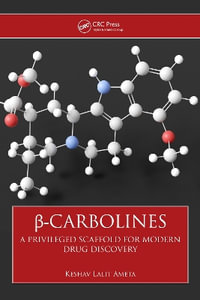
Quantitative Sensory Analysis
Psychophysics, Models and Intelligent Design
By: Harry T. Lawless
Hardcover | 13 September 2013 | Edition Number 1
At a Glance
416 Pages
25.22 x 17.83 x 2.38
Hardcover
$440.75
or 4 interest-free payments of $110.19 with
orAims to ship in 10 to 15 business days
The purpose of this book is to provide an advanced and quantitative approach to sensory science problems. Too often mainstream sensory evaluation, as practiced in the foods and consumer products industries, is primarily concerned with day-to-day tests of pairs of products. Although such testing is often necessary, one can lose sight of the underlying models and theory for product discrimination and quantitative description upon which our test designs and statistical methods are based.
Sensory evaluation procedures have their roots in classical psychophysics and statistical methods. This book will provide a quantitative basis for models underpinning sensory testing for the advanced student and sensory scientist. Topics that lend themselves to quantitative analysis such as the study of mixture interactions, shelf life modeling and threshold estimation are treated. This book is not intended as a guide to data analysis and sensory statistics alone, but treats quantitative modeling in a broader view. Methods that are primarily qualitative, such as focus groups, fuzzy-front end methods and other consumer-driven idea discovery techniques are not within the scope of this book.
Several texts exist on sensory evaluation. These are primarily aimed at the introductory student level. Several statistical texts for sensory data also exist. These do not deal with quantitative modeling issues such as Thurstonian scaling. This book will attempt to place all the quantitative models for sensory phenomena and sensory data in one work. Rather than focus simply on data handling issues, the book will have a psychological emphasis, for example, why experimental designs that use panelists as their own controls are often more powerful for finding product differences.
1 Psychophysics I: Introduction and Thresholds 1
1.1 Introduction and Terminology 1
1.2 Absolute Sensitivity 4
1.3 Methods for Measuring Absolute Thresholds 8
1.4 Differential Sensitivity 13
1.5 A Look Ahead: Fechner?s Contribution 17
Appendix 1.A: Relationship of Proportions, Areas Under the Normal
Distribution, and Z-Scores 18
Appendix 1.B: Worked Example: Fitting a Logistic Function to Threshold Data 20
References 22
2 Psychophysics II: Scaling and Psychophysical Functions 24
2.1 Introduction 24
2.2 History: Cramer, Bernoulli, Weber, and Fechner 26
2.3 Partition Scales and Categories 27
2.4 Magnitude Estimation and the Power Law 28
2.5 Cross-Modality Matching; Attempts at Validation 32
2.6 Two-Stage Models and Judgment Processes 35
2.7 Empirical Versus Theory-Based Functions 39
2.8 Hybrid Scales and Indirect Scales: A Look Ahead 40
2.9 Summary and Conclusions 41
Appendix 2.A: Decibels and Sones 42
Appendix 2.B: Worked Example: Transformations Applied to Non-Modulus
Magnitude Estimation Data 44
References 45
3 Basics of Signal Detection Theory 47
3.1 Introduction 48
3.2 The Yes/No Experiment 49
3.3 Connecting the Design to Theory 52
3.4 The ROC Curve 57
3.5 ROC Curves from Rating Scales; the R-Index 62
3.6 Conclusions and Implications for Sensory Testing 67
Appendix 3.A: Table of p and Z 68
Appendix 3.B: Test for the Significance of Differences Between d? Values 69
References 69
4 Thurstonian Models for Discrimination and Preference 71
4.1 The Simple Paired-Choice Model 71
4.2 Extension into n-AFC: The Byer and Abrams ?Paradox? 78
4.3 A Breakthrough: Power Analysis and Sample Size Determination 80
4.4 Tau Versus Beta Criteria: The Same?Different Test 84
4.5 Extension to Preference and Nonforced Preference 89
4.6 Limitations and Issues in Thurstonian Modeling 90
4.7 Summary and Conclusions 94
Appendix 4.A: The Bradley?Terry?Luce Model: An Alternative to Thurstone 95
Appendix 4.B: Tables for delta Values from Proportion Correct 96
References 97
5 Progress in Discrimination Testing 99
5.1 Introduction 99
5.2 Metrics for Degree of Difference 104
5.3 Replication in Choice Tests 108
5.4 Current Variations 110
5.5 Summary and Conclusions 118
Appendix 5.A: Psychometric Function for the Dual Pair Test, Power
Equations, and Sample Size 119
Appendix 5.B: Fun with g 120
References 121
6 Similarity and Equivalence Testing 124
6.1 Introduction: Issues in Type II Error 124
6.2 Commonsense Approaches to Equivalence 126
6.3 Allowable Differences and Effect Size 133
6.4 Further Significance Testing 138
6.5 Summary and Conclusions 140
References 141
7 Progress in Scaling 143
7.1 Introduction 143
7.2 Labeled Magnitude Scales for Intensity 147
7.3 Adjustable and Relative Scales 153
7.4 Explicit Anchoring 155
7.5 Post Hoc Adjustments 158
7.6 Summary and Conclusions 161
Appendix 7.A: Examples of Individual Rescaling for Magnitude Estimation 162
References 164
8 Progress in Affective Testing: Preference/Choice and Hedonic Scaling 167
8.1 Introduction 167
8.2 Preference Testing Options 168
8.3 Replication 173
8.4 Alternative Models: Ferris k-visit, Dirichlet multinomial 176
8.5 Affective Scales 181
8.6 Ranking and Partial Ranking 185
8.7 Conclusions 188
Appendix 8.A: Proof that the McNemar Test is Equivalent to the Binomial
Approximation Z-Test (AKA Sign Test) 188
References 190
9 Using Subjects as Their Own Controls 194
Part I: Designs using Parametric Statistics 195
9.1 Introduction to Part I 195
9.2 Dependent Versus Independent t-Tests 198
9.3 Within-Subjects ANOVA (?Repeated Measures?) 203
9.4 Issues 206
Part II: Nonparametric Statistics 208
9.5 Introduction to Part II 208
9.6 Applications of the McNemar Test: A?not-A and
Same?Different Methods 209
9.7 Examples of the Stuart?Maxwell 212
9.8 Further Extensions of the Stuart Test Comparisons 218
9.9 Summary and Conclusions 220
Appendix 9.A: R code for the Stuart Test 221
References 222
10 Frequency Counts and Check-All-That-Apply (CATA) 224
10.1 Frequency Count Data: Situations ? Open Ends, CATA 224
10.2 Simple Data Handling 227
10.3 Repeated or Within-Subjects Designs 228
10.4 Multivariate Analyses 230
10.5 Difference from Ideal and Penalty Analysis 231
10.6 Frequency Counts in Advertising Claims 235
10.7 Conclusions 236
Appendix 10.A: Proof Showing Equivalence of Binomial Approximation
Z-Test and c2 Test for Differences of Proportions 237
References 239
11 Time?Intensity Modeling 240
11.1 Introduction: Goals and Applications 240
11.2 Parameters Versus Average Curves 245
11.3 Other Methods and Analyses 250
11.4 Summary and Conclusions 254
References 254
12 Product Stability and Shelf-Life Measurement 257
12.1 Introduction 257
12.2 Strategies, Measurements, and Choices 258
12.3 Study Designs 261
12.4 Hazard Functions and Failure Distributions 261
12.5 Reaction Rates and Kinetic Modeling 267
12.6 Summary and Conclusions 271
References 272
13 Product Optimization, Just-About-Right (Jar ) Scales, and Ideal Profiling 273
13.1 Introduction 273
13.2 Basic Equations, Designed Experiments, and Response Surfaces 276
13.3 Just-About-Right Scales 279
13.4 Ideal Profiling 285
13.5 Summary and Conclusions 292
References 294
14 Perceptual Mapping, Multivariate Tools, and Graph Theory 297
14.1 Introduction 297
14.2 Common Multivariate Methods 299
14.3 Shortcuts for Data Collection: Sorting and Projective Mapping 308
14.4 Preference Mapping Revisited 309
14.5 Cautions and Concerns 311
14.6 Introduction to Graph Theory 314
References 319
15 Segmentation 323
15.1 Introduction 323
15.2 Case Studies 326
15.3 Cluster Analysis 330
15.4 Other Analyses and Methods 336
15.5 Women, Fire, and Dangerous Things 337
References 338
16 An Introduction to Bayesian Analysis 340
16.1 Some Binomial-Based Examples 340
16.2 General Bayesian Models 347
16.3 Bayesian Inference Using Beta Distributions for Preference Tests 349
16.4 Proportions of Discriminators 352
16.5 Modeling Forced-Choice Discrimination Tests 353
16.6 Replicated Discrimination Tests 355
16.7 Bayesian Networks 356
16.8 Conclusions 359
References 360
Appendix A: Overview of Sensory Evaluation 361
A.1 Introduction 361
A.2 Discrimination and Simple Difference Tests 363
A.3 Descriptive Analysis 367
A.4 Affective Tests 372
A.5 Summary and Conclusions 375
References 375
Appendix B: Overview of Experimental Design 377
B.1 General Considerations 377
B.2 Factorial Designs 379
B.3 Fractional Factorials and Screening 380
B.4 Central Composite and Box?Behnken Designs 383
B.5 Mixture Designs 385
B.6 Summary and Conclusions 385
References 386
Appendix C: Glossary 387
Index 398
ISBN: 9780470673461
ISBN-10: 047067346X
Published: 13th September 2013
Format: Hardcover
Language: English
Number of Pages: 416
Audience: Professional and Scholarly
Publisher: John Wiley & Sons (UK)
Country of Publication: US
Edition Number: 1
Dimensions (cm): 25.22 x 17.83 x 2.38
Weight (kg): 0.97
Shipping
| Standard Shipping | Express Shipping | |
|---|---|---|
| Metro postcodes: | $9.99 | $14.95 |
| Regional postcodes: | $9.99 | $14.95 |
| Rural postcodes: | $9.99 | $14.95 |
How to return your order
At Booktopia, we offer hassle-free returns in accordance with our returns policy. If you wish to return an item, please get in touch with Booktopia Customer Care.
Additional postage charges may be applicable.
Defective items
If there is a problem with any of the items received for your order then the Booktopia Customer Care team is ready to assist you.
For more info please visit our Help Centre.
You Can Find This Book In
This product is categorised by
- Non-FictionScienceChemistry
- Non-FictionEngineering & TechnologyOther Technologies & Applied Sciences
- Non-FictionEngineering & TechnologyIndustrial Chemistry & Manufacturing TechnologiesIndustrial ChemistryFood & Beverage Technology
- Non-FictionEngineering & TechnologyIndustrial Chemistry & Manufacturing TechnologiesIndustrial ChemistryPigmentsCosmetics Technology
- Non-FictionEngineering & TechnologyTechnology in General























